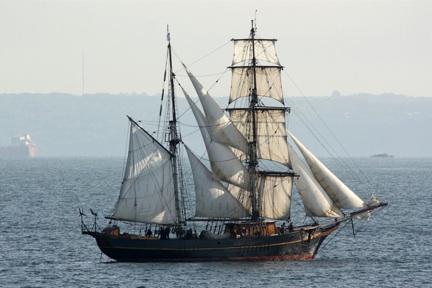 The last month has seen exciting U.S. sail-transport developments. Three encouraging events indicate that the nation may no longer be falling behind Europe in nurturing a critical form of renewable energy. In northern Europe at least four well-established players are operating on a significant scale, and preparing to build more ships. Previous reports this summer on SailTransportNetwork.com have discussed these entities' exciting voyages and plans for new vessels. Due in part to the constant promotion of sail power by the Sail Transport Network and participating sailors since 1999, the U.S. is finally rising to the occasion. The occasion is none other than the recent historic global peaking of easy-to-extract-and-refine conventional crude oil, and the accelerating destabilization of the Earth's benign climate.
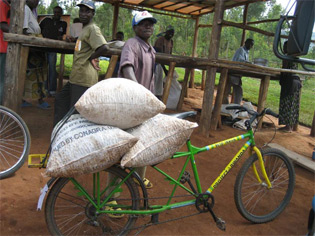 Coffee Bike, Rwanda. - courtesy Thanksgiving Coffee Co.
When corporations get meaningful business at "profit centers" outside the corporations' main line of products or services, they tend to react. If there is promise of growth or occupying a niche market with an advantageous share, practices and priorities can shift. Witness the more vegetarian options at fast food "restaurants." But an activist campaign can occasionally be the stimulus for a shift in business practices. This has usually been in the form of boycotts, which have sometimes worked. However, coffee drinkers are not about to boycott coffee in order to force an importer or roaster to cease bunker-fuel emissions. So, a more positive and comfortable approach is to reward the corporation for more environmentally sensitive or human-rights appropriate behavior. Taking this principle a step further, purchases of the product (Thanksgiving Coffee) are made in advance in order to offset costs related to establishing sail power. And the Fort Bragg, California corporation in this case has led the way.
The Carrotmob campaign features an entertaining video on the coffee-sailing project, titled Buy Coffee to Fight Climate Change!
Here is how Carrotmob works: 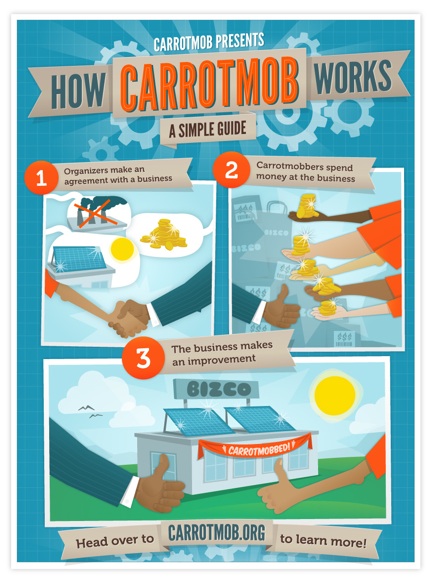 One of the videos on the website addresses the cargo shipping industry's trend toward greater efficiency (authority cited: Carbon War Room at shippingefficiency.org). But some of us feel it is too late and perhaps pointless to try to "green" oil-burning cargo boats that can never function solely with wind power. Carrotmob and Thanksgiving Coffee do understand the difference. In their global coffee campaign's website they state,
For details on the approach Carrotmob and Thanksgiving are taking, see the website sections "About the action Thanksgiving Coffee will take" and "About the money" at carrotmob.org in "View more details." This sail-transport commitment by a company that has won awards for sustainable coffee sourcing and production is historic. They are plunging into the waters of change, knowing it is the future of business in the post-peak oil, greenhouse world. Let us assist this bold effort by buying some advance-sail-transported coffee today, at store.thanksgivingcoffee.com. * * * * * Jan Lundberg is founder of the Sail Transport Network and author of Songs of Petroleum.
The video: Cargo Ship Designers Turn to Wind to Cut Cost and Emissions, the New York Times, Aug. 27, 2012, by John Geoghegan. 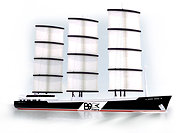 B9's ship design, testing complete
To reduce emissions and conserve expensive fossil fuels, cargo ship designers are turning to the oldest source of power there is: the wind. Featured: B9 Shipping
Petition campaign: Hanna Broback wrote the campaign's article "Prioritize Development of Wind-Powered Cargo Ships" on September 4, 2012. The busiest European deal-maker in sail transported goods and distribution is Guillaume Le Grand, founder of Trans Oceanic Wind Transport. Its current voyage is another wine shipment that you can read about in French at Les vins nantais naviguent vers Brest à la voile 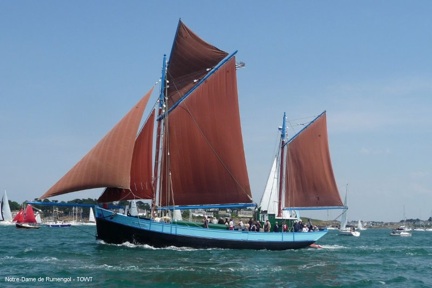 Notre-Dame de Rumengol, chartered by TOWT
Catch up with Fair Transport and its Tres Hombres schooner-brig on their website. * * * * * To support the Sail Transport Network and the global sail transport movement, please make a donation of time or money. Our wish list for various kinds of assistance is on the STN brochure, available upon request online or hard copy. Helping sail transport is fun!
Online the STN website we have a secure donation page. PayPal works, or you can mail a check to 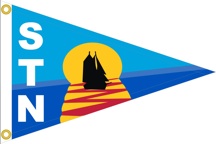 |
|||
 |
||
|
|

